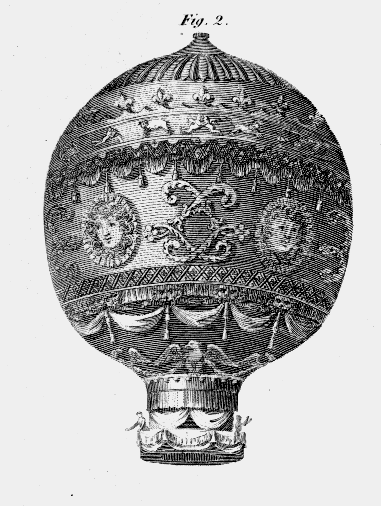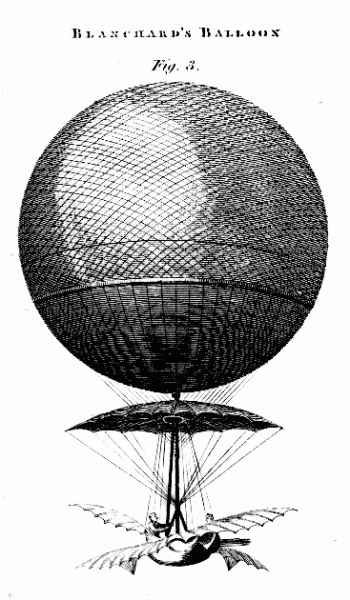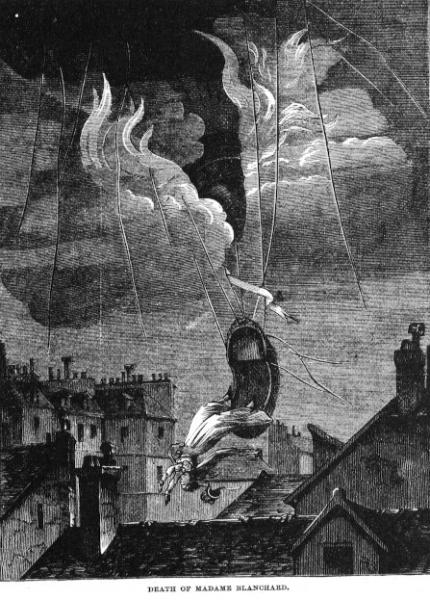M. & Mme Blanchard
Today, we join George Washington at a balloon ascent. The University of Houston's College of Engineering presents this series about the machines that make our civilization run, and the people whose ingenuity created them.
The first untethered manned balloon flight was made on November 21, 1783. It was Joseph and Etienne Montgolfier's famous hot air ballon. Unmanned balloons had been laying hold of Europe's imagination throughout that year. Four months earlier, 16-year-old John Quincy Adams and 77-year-old Ben Franklin had watched as Alexandre Charles tested an unmanned hydrogen balloon in Paris. That was where someone asked Franklin what use this all could be, and he gave his much-quoted answer, "What good is a new-born baby?"
Soon everyone was flying, and they got to altitudes limited only by their ability to breathe thin air. Four months after the Montgolfiers, Jean-Pierre Blanchard flew. But he changed the game. He took his balloons on the road and became the first barnstormer.
In England an American doctor, John Jeffries, hired Blanchard to fly him from England to France. They had no common language, but that didn't keep them from achieving a fine mutual dislike as they skirmished over funding and credit for the flight. Still, they made the first aerial crossing of the English Channel in 1785.
Blanchard was an experimenter. He was first to drop animals in parachutes and first to try controlling his flights with flapping paddles. All that cost him more money than he could raise. So he took his act to America, where he hoped to do better. He arranged to make the first untethered American flight in Philadelphia on January 9, 1793. The Quakers had built a model prison that offered means for hiding his takeoff from nonpaying watchers. He cut a deal with the Quakers and then advertised in the Federal Gazette: Come watch the ascent for five dollars a person!
He collected 405 dollars against 500 dollars' worth of expenses and took off before a crowd that included President Washington. He landed in New Jersey, served his remaining wine to local farmers, and they carted his balloon into town on their wagon.
Blanchard died sixteen years later after suffering a heart attack on his 59th flight. After that his second wife, Marie, continued the act. The problem was, he'd used hydrogen in preference to hot air in his balloons, and so did she. Then she made the tactical error of improving the show with aerial fireworks. Her flights were fine successes until she made a flight over Paris's Tivoli Gardens in 1819. This time she set the hydrogen on fire.
The gas burned off, and the balloon fell to a rooftop. Marie Blanchard survived up to that point, but she was spilled out onto the roof. She slid off the edge and fell to her death in the street below.
That sounds like a pretty unhappy ending, of course. But self-preservation was low on any priority list of early fliers. Those primordial balloonists were driven by excitement. And our best technologies are always born in excitement and enthusiasm -- far more than they are in any pursuit of purpose.
I'm John Lienhard, at the University of Houston, where we're interested in the way inventive minds work.
(Theme music)
Crouch, T. D., The Eagle Aloft: Two Centuries of the Balloon in America. Washington D.C.: Smithsonian Institution Press, 1983.
Jackson, D. D., The Aeronauts. Alexandria, VA: Time-Life Books, 1981.
Rolt, L. T. C., The Aeronauts -- A History of Ballooning, 1783-1903. New York: Walker and Company, 1966.
This is a revised version of Episode 39.

The Montgolfier brothers' first man-carrying balloon
From the 1832 Edinburgh Encyclopaedia

Blanchard's hydrogen balloon with paddles for navigation
From the 1832 Edinburgh Encyclopaedia

Artist's image of the death of Madame Blanchard
From Harper's New Monthly Magazine, 1869